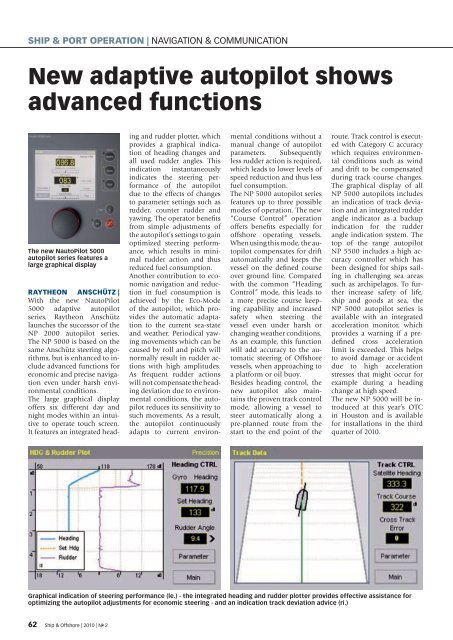| 2 | 2010 - Schiff & Hafen
| 2 | 2010 - Schiff & Hafen
| 2 | 2010 - Schiff & Hafen
Create successful ePaper yourself
Turn your PDF publications into a flip-book with our unique Google optimized e-Paper software.
SHIP & PORT OPERATION | NAVIGATION & COMMUNICATION<br />
New adaptive autopilot shows<br />
advanced functions<br />
The new NautoPilot 5000<br />
autopilot series features a<br />
large graphical display<br />
RAYTHEON ANSCHÜTZ |<br />
With the new NautoPilot<br />
5000 adaptive autopilot<br />
series, Raytheon Anschütz<br />
launches the successor of the<br />
NP 2000 autopilot series.<br />
The NP 5000 is based on the<br />
same Anschütz steering algorithms,<br />
but is enhanced to include<br />
advanced functions for<br />
economic and precise navigation<br />
even under harsh environmental<br />
conditions.<br />
The large graphical display<br />
offers six different day and<br />
night modes within an intuitive<br />
to operate touch screen.<br />
It features an integrated heading<br />
and rudder plotter, which<br />
provides a graphical indication<br />
of heading changes and<br />
all used rudder angles. This<br />
indication instantaneously<br />
indicates the steering performance<br />
of the autopilot<br />
due to the effects of changes<br />
to parameter settings such as<br />
rudder, counter rudder and<br />
yawing. The operator benefits<br />
from simple adjustments of<br />
the autopilot’s settings to gain<br />
optimized steering performance,<br />
which results in minimal<br />
rudder action and thus<br />
reduced fuel consumption.<br />
Another contribution to economic<br />
navigation and reduction<br />
in fuel consumption is<br />
achieved by the Eco-Mode<br />
of the autopilot, which provides<br />
the automatic adaptation<br />
to the current sea-state<br />
and weather. Periodical yawing<br />
movements which can be<br />
caused by roll and pitch will<br />
normally result in rudder actions<br />
with high amplitudes.<br />
As frequent rudder actions<br />
will not compensate the heading<br />
deviation due to environmental<br />
conditions, the autopilot<br />
reduces its sensitivity to<br />
such movements. As a result,<br />
the autopilot continuously<br />
adapts to current environmental<br />
conditions without a<br />
manual change of autopilot<br />
parameters. Subsequently<br />
less rudder action is required,<br />
which leads to lower levels of<br />
speed reduction and thus less<br />
fuel consumption.<br />
The NP 5000 autopilot series<br />
features up to three possible<br />
modes of operation. The new<br />
“Course Control” operation<br />
offers benefits especially for<br />
offshore operating vessels.<br />
When using this mode, the autopilot<br />
compensates for drift<br />
automatically and keeps the<br />
vessel on the defined course<br />
over ground line. Compared<br />
with the common “Heading<br />
Control” mode, this leads to<br />
a more precise course keeping<br />
capability and increased<br />
safety when steering the<br />
vessel even under harsh or<br />
changing weather conditions.<br />
As an example, this function<br />
will add accuracy to the automatic<br />
steering of Offshore<br />
vessels, when approaching to<br />
a platform or oil buoy.<br />
Besides heading control, the<br />
new autopilot also maintains<br />
the proven track control<br />
mode, allowing a vessel to<br />
steer automatically along a<br />
pre-planned route from the<br />
start to the end point of the<br />
route. Track control is executed<br />
with Category C accuracy<br />
which requires environmental<br />
conditions such as wind<br />
and drift to be compensated<br />
during track course changes.<br />
The graphical display of all<br />
NP 5000 autopilots includes<br />
an indication of track deviation<br />
and an integrated rudder<br />
angle indicator as a backup<br />
indication for the rudder<br />
angle indication system. The<br />
top of the range autopilot<br />
NP 5500 includes a high accuracy<br />
controller which has<br />
been designed for ships sailing<br />
in challenging sea areas<br />
such as archipelagos. To further<br />
increase safety of life,<br />
ship and goods at sea, the<br />
NP 5000 autopilot series is<br />
available with an integrated<br />
acceleration monitor, which<br />
provides a warning if a predefined<br />
cross acceleration<br />
limit is exceeded. This helps<br />
to avoid damage or accident<br />
due to high acceleration<br />
stresses that might occur for<br />
example during a heading<br />
change at high speed.<br />
The new NP 5000 will be introduced<br />
at this year’s OTC<br />
in Houston and is available<br />
for installations in the third<br />
quarter of <strong>2010</strong>.<br />
Graphical indication of steering performance (le.) - the integrated heading and rudder plotter provides effective assistance for<br />
optimizing the autopilot adjustments for economic steering - and an indication track deviation advice (ri.)<br />
62 Ship & Offshore | <strong>2010</strong> | N o 2
















